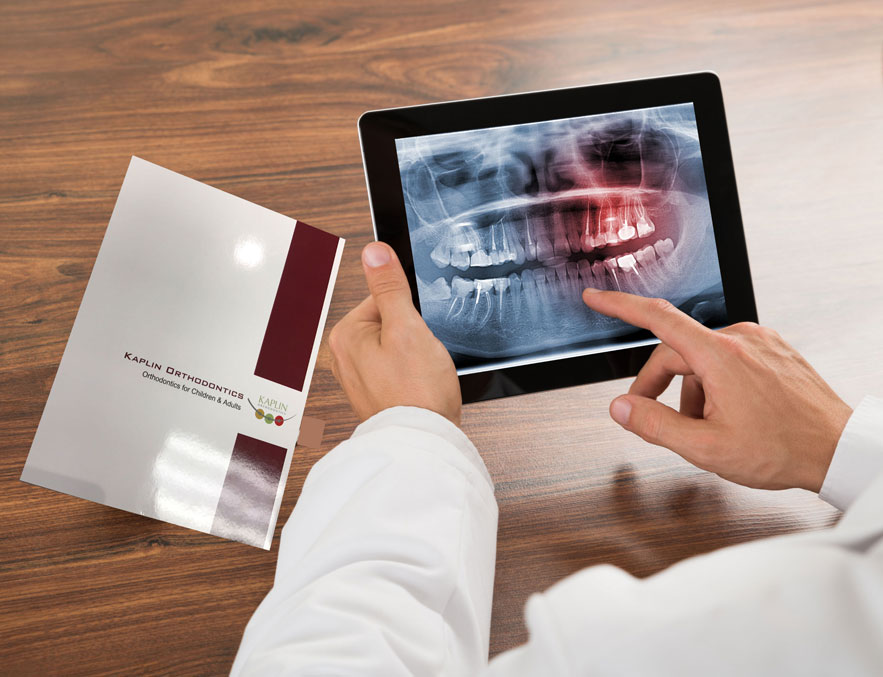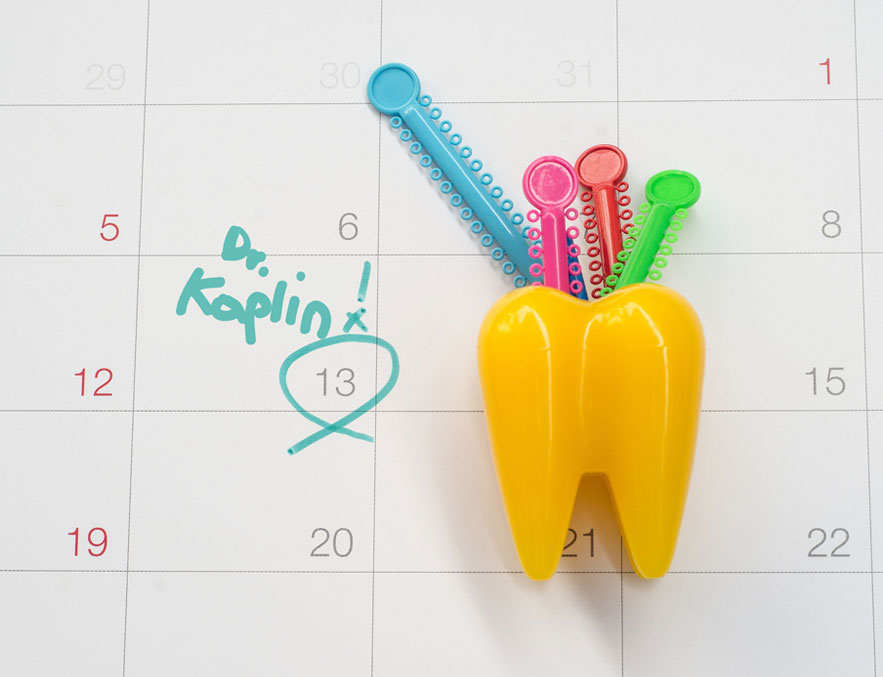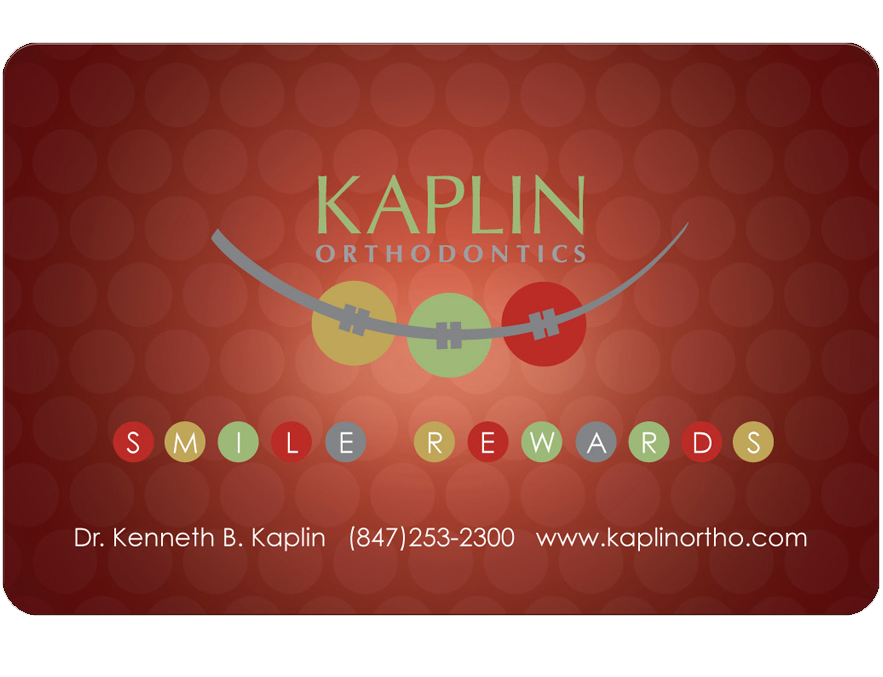We are usually asked about:
Why select an orthodontist?
Orthodontists are dental specialists who diagnose, prevent and treat dental and facial irregularities. They receive an additional two to three years of specialized education beyond dental school to learn the proper way to align and straighten teeth. Only those with this formal education may call themselves orthodontists, and only orthodontists may be members of the American Association of Orthodontists (AAO).
Why is orthodontic treatment important?
Crooked and crowded teeth are hard to clean and maintain. This may contribute to conditions that cause not only tooth decay but also eventual gum disease and tooth loss. Other orthodontic problems can contribute to abnormal wear of tooth surfaces, inefficient chewing function, excessive stress on gum tissue and the bone that supports the teeth, or misalignment of the jaw joints, which can result in chronic headaches or pain in the face or neck.
When left untreated, many orthodontic problems become worse. Treatment by a specialist to correct the original problem is often less costly than the additional dental care required to treat more serious problems that can develop in later years.
The value of an attractive smile should not be underestimated. A pleasing appearance is a vital asset to one’s self-confidence. A person’s self-esteem often improves as treatment brings teeth, lips and face into proportion. In this way, orthodontic treatment can benefit social and career success, as well as improve one’s general attitude towards life.
What does orthodontic treatment cost?
The actual cost of treatment depends on several factors, including the severity of the patient’s problem and the treatment approach selected. You will be able to thoroughly discuss fees and payment options before any treatment begins.
How long will orthodontic treatment take?
In general, active treatment time with orthodontic appliances (braces) ranges from one to three years. Interceptive, or early treatment procedures, may take only a few months. The actual time depends on the growth of the patient’s mouth and face, the cooperation of the patient and the severity of the problem. Mild problems usually require less time, and some individuals respond faster to treatment than others. Use of rubber bands if prescribed by Dr. Kaplin, contributes to completing treatment as scheduled.
While orthodontic treatment requires a time commitment, patients are rewarded with prizes and healthy teeth, proper jaw alignment and a beautiful smile that lasts a lifetime. Teeth and jaws in proper alignment look better, work better contribute to general physical health and can improve self-confidence.
How have new "high tech" wires changed orthodontics?
In recent years, many advances in orthodontic materials have taken place. Braces are smaller and more efficient. The wires now being used are no longer just stainless steel. They are made of alloys of nickel, titanium, copper and cobalt, and some of the wires are heat-activated. (The nickel-titanium alloy was originally engineered by NASA to automatically activate antennae or solar panels of spacecraft orbiting into the sun’s rays.) These new kinds of wires cause the teeth to continue to move during certain phases of treatment, which may reduce the number of appointments, needed to make adjustments to the wires.
How do braces feel?
Most people have some discomfort after their braces are first put on or when adjusted during treatment. After the braces are on, teeth may become sore and may be tender to biting pressures for three to five days. Patients can usually manage this discomfort well with whatever pain medication they might commonly take for a headache. Dr. Kaplin will advise patients and/or their parents what, if any, pain relievers to take. The lips, cheeks and tongue may also become irritated for one to two weeks as they toughen and become accustomed to the surface of the braces. Overall, orthodontic discomfort is short-lived and easily managed.
What causes orthodontic problems?
Most orthodontic problems are inherited. Examples of these genetic problems are crowding, spacing, protrusion, extra or missing teeth and some jaw growth problems. Other malocclusions are acquired by thumb or finger-sucking, dental disease, accidents, the early or late loss of baby (primary) teeth.
Why is treatment so important?
Crooked and crowded teeth are hard to clean and maintain. A bad bite can also cause abnormal wear of tooth surfaces, difficulty in chewing and/or speaking, and excess stress on supporting bone and gum tissue. Without treatment, many problems become worse and can require additional dental care later in life.
When should children get an orthodontic check-up?
The AAO recommends that your child gets an orthodontic check-up no later than age 8. By this age, orthodontists can spot subtle problems with jaw growth and emerging teeth while some baby teeth are still present. That’s important, because some orthodontic problems may be easier to correct if they are found early. Most orthodontic patients begin active treatment between ages 9 and 14.
By age 7, enough permanent teeth have come in and enough jaw growth has occurred that the dentist or orthodontist can identify current problems, anticipate future problems and alleviate parents concerns if all seems normal. The first permanent molars and incisors have usually come in by age 7, and crossbites, crowding and developing injury-prone dental protrusions can be evaluated. Any ongoing thumb/finger-sucking, tongue issues, and other oral habits can be assessed at this time also.
Some signs or habits that may indicate the need for an early orthodontic examination are:
- early or late loss of baby teeth
- difficulty in chewing or biting
- mouth breathing
- thumb sucking
- finger sucking
- crowding, misplaced or blocked out teeth
- jaws that shift or make sounds
- biting the cheek or roof of the mouth
- teeth that meet abnormally or not at all, and
- jaws and teeth that are out of proportion to the rest of the face
A check-up with an orthodontic specialist no later than age 7 enables the orthodontist to detect and evaluate problems (if any), advise if treatment will be necessary, and determine the best time for that patient to be treated.
What are the benefits of early treatment?
For those patients who have clear indications for early orthodontic intervention, early treatment presents an opportunity to:
- guide the growth of the jaw,
- regulate the width of the upper and lower dental arches (the arch-shaped jaw bone that supports the teeth),
- guide incoming permanent teeth into desirable positions,
- lower risk of trauma (accidents) to protruded upper incisors (front teeth),
- correct harmful oral habits such as thumb- or finger-sucking,
- reduce or eliminate abnormal swallowing or speech problems,
- improve personal appearance and self-esteem,
- potentially simplify and/or shorten treatment time for later corrective orthodontics,
- reduce likelihood of impacted permanent teeth (teeth that should have come in, but have not),
- and preserve or gain space for permanent teeth that are coming in.
What is a space maintainer?
Baby molar teeth, also known as primary molar teeth, hold needed space for permanent teeth that will come in later. When a baby molar tooth is lost, an orthodontic device with a fixed wire is usually put between teeth to hold the space for the permanent tooth, which will come in later.
Why do baby teeth sometimes need to be pulled?
Pulling baby teeth may be necessary to allow severely crowded permanent teeth to come in at a normal time in a reasonably normal location. If the teeth are severely crowded, it may be clear that some unerupted permanent teeth (usually the canine teeth) will either remain impacted (teeth that should have come in, but have not), or come in to a highly undesirable position. To allow severely crowded teeth to move on their own into much more desirable positions, sequential removal of baby teeth and permanent teeth (usually first premolars) can dramatically improve a severe crowding problem. This sequential extraction of teeth, called serial extraction, is typically followed by comprehensive orthodontic treatment after tooth eruption has improved as much as it can on its own.
After all the permanent teeth have come in, the pulling of permanent teeth may be necessary to correct crowding or to make space for necessary tooth movement to correct a bite problem. Proper extraction of teeth during orthodontic treatment should leave the patient with both excellent function and a pleasing look.
How can a child's growth affect orthodontic treatment?
Orthodontic treatment and a child’s growth can complement each other. A common orthodontic problem to treat is protrusion of the upper front teeth ahead of the lower front teeth. Quite often this problem is due to the lower jaw being shorter than the upper jaw. While the upper and lower jaws are still growing, orthodontic appliances can be used to help the growth of the lower jaw catch up to the growth of the upper jaw. Abnormal swallowing may be eliminated. A severe jaw length discrepancy, which can be treated quite well in a growing child, might very well require corrective surgery if left untreated until a period of slow or no jaw growth. Children who may have problems with the width or length of their jaws should be evaluated for treatment no later than age 10 for girls and age 12 for boys. The AAO recommends that all children have an orthodontic screening no later than age 8 as growth-related problems may be identified at this time.
What are the most commonly treated orthodontic problems?
Crowding: Teeth may be aligned poorly because the dental arch is small and/or the teeth are large. The bone and gums over the roots of extremely crowded teeth may become thin and recede as a result of severe crowding. Impacted teeth (teeth that should have come in, but have not), poor biting relationships and undesirable appearance may all result from crowding:
- Overjet or protruding upper teeth: Upper front teeth that protrude beyond normal contact with the lower front teeth are prone to injury, often indicate a poor bite of the back teeth (molars), and may indicate unevenness in jaw growth. Commonly, protruded upper teeth are associated with a lower jaw that is short in proportion to the upper jaw. Thumb and finger sucking habits can also cause a protrusion of the upper incisor teeth.
- Deep overbite: A deep overbite or deep bite occurs when the lower incisor (front) teeth bite too close or into the gum tissue behind the upper teeth. When the lower front teeth bite into the palate or gum tissue behind the upper front teeth, significant bone damage and discomfort can occur. A deep bite can also contribute to excessive wear of the incisor teeth.
- Open bite: An open bite results when the upper and lower incisor teeth do not touch when biting down. This open space between the upper and lower front teeth causes all the chewing pressure to be placed on the back teeth. This excessive biting pressure and rubbing together of the back teeth makes chewing less efficient and may contribute to significant tooth wear.
- Spacing: If teeth are missing or small, or the dental arch is very wide, space between the teeth can occur. The most common complaint from those with excessive space is poor appearance.
- Crossbite: The most common type of a crossbite is when the upper teeth bite inside the lower teeth (toward the tongue). Crossbites of both back teeth and front teeth are commonly corrected early due to biting and chewing difficulties.
- Underbite or lower jaw protrusion: About 3 to 5 percent of the population has a lower jaw that is to some degree longer than the upper jaw. This can cause the lower front teeth to protrude ahead of the upper front teeth creating a crossbite. Careful monitoring of jaw growth and tooth development is indicated for these patients.
What kinds of orthodontic appliances are typically used to correct jaw-growth problems?
Correcting jaw-growth problems is done by the process of dentofacial orthopedics. Some of the more common orthopedic appliances used by orthodontists today that help the length of the upper and lower jaws become more compatible include:
- Headgear: This appliance applies pressure to the upper teeth and upper jaw to guide the rate and direction of upper jaw growth and upper tooth eruption. The headgear may be removed by the patient and is usually worn 8 to 10 hours per day.
- Herbst: The Herbst appliance is usually fixed to the upper and lower molar teeth and may not be removed by the patient. By holding the lower jaw forward and influencing jaw growth and tooth positions, the Herbst appliance can help correct severe protrusion of the upper teeth.
- Palatal Expansion Appliance: A child’s upper jaw may also be too narrow for the upper teeth to fit properly with the lower teeth (a crossbite). When this occurs, a palatal expansion appliance can be fixed to the upper back teeth. This appliance can markedly expand the width of the upper jaw.
The decision about when and which of these or other appliances to use for orthopedic correction is based on each individual patient’s problem. Usually one of several appliances can be used effectively to treat a given problem. Patient cooperation and the experience of the treating orthodontist are critical elements in success of dentofacial orthopedic treatment.
Can my child play sports while wearing braces?
Yes. Wearing a protective mouth guard is advised while playing any contact sports. We offer different sizes and colors at no extra charge.
Will my braces interfere with playing musical instruments?
Playing wind or brass instruments, such as the trumpet, will clearly require some adaptation to braces. With practice and a period of adjustment, braces typically do not interfere with the playing of musical instruments.
Why does orthodontic treatment time sometimes last longer than anticipated?
Estimates of treatment time can only be that – estimates. Patients grow at different rates and will respond in their own ways to orthodontic treatment. The orthodontist has specific treatment goals in mind, and will usually continue treatment until these goals are achieved. Patient cooperation, however, is the single best predictor of staying on time with treatment. Patients who cooperate by wearing rubber bands, headgear or other needed appliances as directed, while taking care not to damage appliances, will most often lead to on-time and excellent treatment results.
Why are retainers needed after orthodontic treatment?
After braces are removed, the teeth can shift out of position if they are not stabilized. Retainers provide that stabilization. They are designed to hold teeth in their corrected, ideal positions until the bones and gums adapt to the treatment changes. Wearing retainers exactly as instructed is the best insurance that the treatment improvements last for a lifetime.
Will my child's tooth alignment change later?
Studies have shown that as people age, their teeth may shift. This variable pattern of gradual shifting, called maturational change, probably slows down after the early 20s, but still continues to a degree throughout life for most people. Even children whose teeth developed into ideal alignment and bite without treatment may develop orthodontic problems as adults. The most common maturational change is crowding of the lower incisor (front) teeth. Wearing retainers as instructed after orthodontic treatment will stabilize the correction. Beyond the period of full-time retainer wear, nighttime retainer wear can prevent maturational shifting of the teeth.
What about the wisdom teeth (third molars) - should they be removed?
In about three out of four cases where teeth have not been removed during orthodontic treatment, there are good reasons to have the wisdom teeth removed, usually when a person reaches his or her mid- to late-teen years. Careful studies have shown, however, that wisdom teeth do not cause or contribute to the progressive crowding of lower incisor teeth that can develop in the late teen years and beyond. Your orthodontist, in consultation with your family dentist, can determine what is right for you.
Can adults benefit from orthodontic treatment?
Orthodontic treatment can be successful at almost any age. In fact, about one in every five orthodontic patients today is over age 18. Thanks to today’s smaller, less visible, more comfortable orthodontic appliances, including fixed braces and removable appliances, adults are finding treatment more appealing.
What is my role in treatment?
Orthodontic treatment is a partnership of the doctor and patient. The orthodontist provides custom-made fixed or removable appliances that use gentle pressure to move teeth into their proper positions. For the patient, orthodontic treatment always requires following the orthodontist’s instructions, keeping scheduled orthodontic appointments and maintaining excellent oral hygiene to achieve the best results. You will also need to see your general dentist as recommended to continue your general dental care.
How long does treatment take?
Patients who need orthodontic treatment generally have one to three years of active treatment, plus retention.
How much does treatment cost?
The cost of orthodontic treatment will depend on many factors, including the severity of the problem, its complexity and length of treatment. Dr. Kaplin will be glad to discuss the cost of treatment and your financing options with you before treatment begins. Patients are finding that braces are more affordable today than ever.
What is Phase I and Phase II treatment?
What is Phase I and Phase II?
Phase I, or early interceptive treatment, is limited orthodontic treatment (e.g., expander or partial braces) before all of the permanent teeth have erupted. Such treatment can occur between the ages of six and ten. This treatment is sometimes recommended to make more space for developing teeth, correction of crossbites, overbites, and underbites, or harmful oral habits. Phase II treatment is also called comprehensive treatment because it involves full braces when all of the permanent teeth have erupted, usually between the ages of eleven and thirteen.




